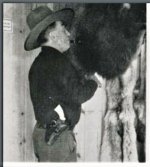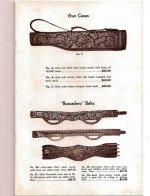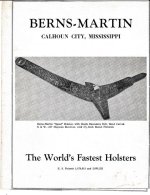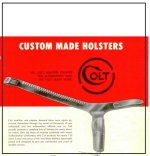Oh what a tangled web they weaved,
for Red to unscramble. God Job!
for Red to unscramble. God Job!
Yes, of course, the Lawrence's are Threepersons Style. I see that even when laced the Keith has a welt inside! Unusual in that regard. The little gap in the welt at the fold of the holster: Heiser makes an issue of it, in their catalogues. I dunno that anyone else but Heiser thought anything of it; it appears from time to time in all Threepersons holsters except the Brills because it's a natural result of placing the welt so it doesn't interfere with folding the holster. But Brill went to the trouble to actually round the end of the welts (there are three thre!) to fill that gap.
The back of that beautiful Lawrence, which holster was equally beautifully photographed by its seller:
View attachment 331451
Oddly it was re-sold not long after and didn't photograph nearly as nicely for that auction.
The earliest I find the 34 is in Lawrence's 1952 catalogue; whilst the Keith 120 in the 1945 catalogue (turnerriver might weigh in on this). Elmer claims to have 'designed' both holsters for the company; but I reckon his contribution was to tell them to add something that would compete with the Myres 614. Both the Myres and the Keith appear with the long safety strap that has been attributed to Elmer.

Great information and a tribute to Red Nichols' exceptional research.
My holster making career was from 1972 to 2015, during which time I made hundreds of "Threepersons-style" holsters. I can see now that my choice of that description was at least as accurate as the historical record allows.
I will bow to the superior knowledge of the "holstorian" on this topic. Very well done, sir!
Amen to that Ray.
By the way, you were no slouch when it came to Tom Threepersons. Here is one you made for me, slightly
modified with a "dog ear".
I remember making that holster. Probably about 2011 or so, if my old rememberer still functions (my fergitter is working a lot better these days).
The "dog ear" is actually a hammer shield, intended to protect the user's arm and clothing from contact with sharp edges of the hammer and rear sight. Based on the designs popularized by Hank Sloan, and frequently referred to as a "Hank Sloan-style" holster. Popular with plain-clothes cops back in the 1960's and 1970's. I first saw this style holster while attending a brief training program at the FBI Academy at Quantico, VA in about 1971 or 1972. I found it to be quite useful for keeping the linings of my suit jackets from being torn to shreds by the hammer and rear sight, and I made quite a few of that style until the latter 1980's when semi-auto pistols started displacing revolvers in cops' holsters.
Your Herrett's "Jordan Trooper" grips are another blast from the past! Very nice!
My avatar photo shows a very similar holster made for my old 6" Model 19 with a very nice hand carved floral pattern. One of my personal favorites.
We had quite a little discussion on this forum 4 or 5 years ago
about the origination of the little leather tab that I call a "dog
ear" and you call a hammer shield. Tex Shoemaker probably
described it best. He called it a clothing protector.
John Bianchi told me that Wally Wolfram designed the hammer
protector for small revolvers....and doubted that there were any
commercially succesful models before Wally's.
Actually the so called "dog ear" came along in the 1940s. The
first may have been by Myres. Wally was in the Air Corp during
WWII, so his probably didn't come along until later.
Here, on the left, is an old model 624 by Myres. I don't know
how old it is.
2nd from left is an old one by Wally Wolfram when he used
the Wolf brand name in Albuquerque. Probably late 1940s.

I like the look of heavy carved Berns-Martin wide contoured belts I've seen pictures of. They look very comfortable and practical, though maybe too wide for some people. When did they start making those after Heiser?
Jack Palance's rig in Shane had two Heiser holsters on a belt that I think was said to be Heiser, too, in old posts here or elsewhere. the way that belt fit him always gave me the impression it was contoured, it looked that good.

 Ironically the holster is held to the belt with an overlying strap -- which was the original design of the Buscadero for Capt. Hughes. Myres did not use this method.
Ironically the holster is held to the belt with an overlying strap -- which was the original design of the Buscadero for Capt. Hughes. Myres did not use this method.


